[PHOTOS] 40 years (and more) of drag in West Hollywood
Drag performers are more than just entertainers: they are activists and community leaders who have helped lift spirits, raise funds, and lead campaigns.

Presented as part of the City of West Hollywood’s 40th anniversary, It’s Where I Belong tells the story of this unique landmark for fierce and fabulous drag performance.
Long before drag queens and kings became international superstars, they held a place of pride as local legends. Rooted deeply in community, drag performers serve flawless artistry, colorful cultural commentary, and unabashed challenges to the status quo. However, even while drag has been celebrated, it has also faced challenges: from raids on nightlife venues to attacks from conservative politicians. And yet, drag artists continue to fight back, proving that glamour is a crucial tactic of queer resistance and joy.
Central to the exhibition is a salon-style wall of photographs—gathered from institutional archives and community members’ closets—highlighting the intimacy and expressiveness of drag. These stunning images showcase the thrill of dressing up for one’s first Pride or Halloween festivities and the dedication of professional drag artists who routinely make magic on stages, screens, and the streets.
As with all things drag, too much is never enough: every sequin, swish, and side-eye tells its own story. Curator Lil Miss Hot Mess has graciously shared her favorite photos with GayCities.
Related
Drag queen forces cops to wait until she finishes her number during bar raid
When police swarmed the bar over liquor license violations, drag artist Blade Matthews took the stage. What she did was iconic.
Individual Photos & Objects


In addition to materials from the ONE Archives at USC Libraries, the exhibition features images contributed through a community call.

Throughout the exhibit, visitors will spot celebrities like Lucille Ball, Bea Arthur, and Jennifer Coolidge, and several music videos also highlight collaborations with Diana Ross, Gloria Estefan, and Chappell Roan.

Drag kings share many affinities with queens, but also present unique styles of drag that are all their own. Unfortunately, West Hollywood (like many gay locales and venues) has not always been a welcoming home to drag kings, though in recent years, that has begun to change. In the spirit of conjuring more drag king events in West Hollywood (and beyond), the exhibit presents a collection of archival materials stretching out across Los Angeles County.

Drag performers are more than just entertainers: they are activists and community leaders who have helped lift spirits, raise funds, and lead campaigns at various historical moments.

The cheerleaders can be seen in many iterations across the gallery’s walls.

Drag doesn’t only happen in nightclubs and parades, but also at home: in the intimacy of getting ready and the creation of chosen families.

Before the advent of social media, drag performers and LGBTQ+ communities created their own print media, from glossy magazines to DIY zines. The exhibition includes cover stories of drag kings in famed lesbian magazines Curve and On Our Backs, as well as contemporary zines created by Manny Oakley and Samara Goodman.
It’s Where I Belong is organized by One Institute, curated by Lil Miss Hot Mess. This exhibition is made possible through an arts grant from the City of West Hollywood. Special thanks to ONE Archives at USC Libraries and local community members who contributed loans and exhibition copies.
Installation Shots
Drag is both a material and ephemeral art form: on the one hand, offering rich archives of glitter and sequins, but on the other, leaving only the slightest trace of legendary moments in one’s mind. As seen here, the exhibit also showcases costumes (including this one from legendary queen Jackie Beat), as well as video (here a collection of archival videos of drag king performances from around Los Angeles).
The exhibition draws inspiration and source material from homegrown archives and collections at the ONE Archives at USC, constructing an extended drag family across West Hollywood and beyond.
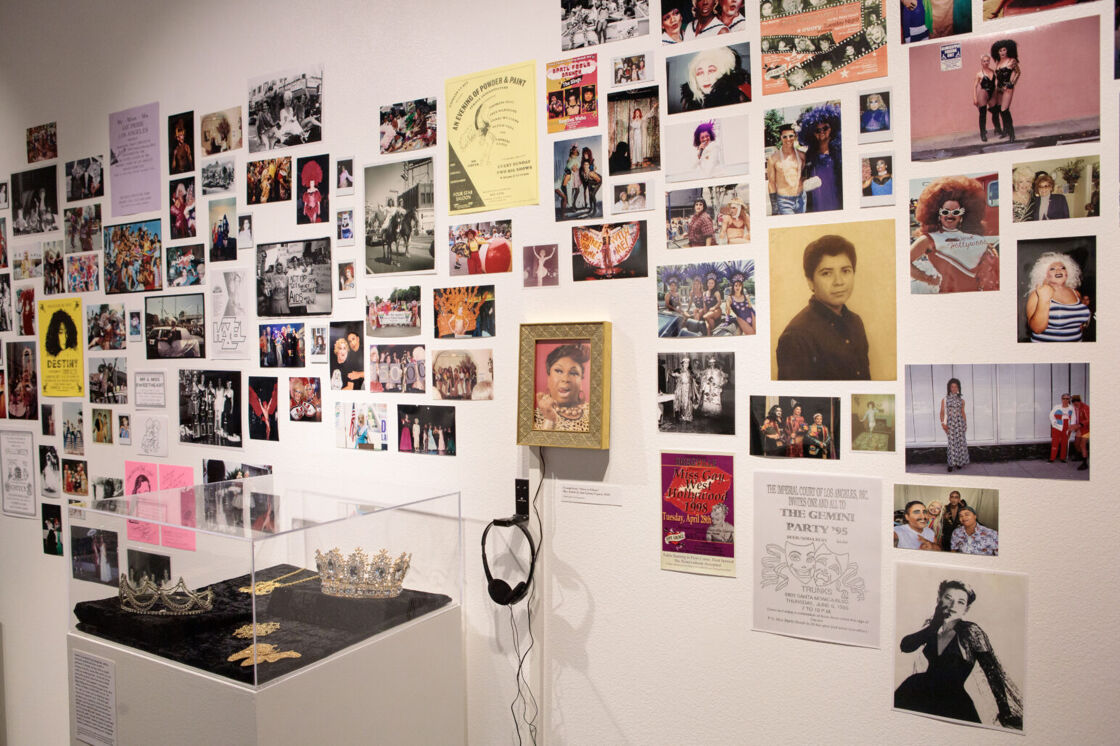
This wall of images not only celebrates the gorgeous diversity of drag culture but also invites reflections on who is missing and insists that the project of building a community of belonging is always a work in progress. Encouraging drag performers of different aesthetics, scenes, and eras to “rub elbows” with one another offers an urgent reminder of the power and possibility in expressing one’s most authentic self while building unwavering solidarity.

The exhibition also documents the power of drag to build community and catalyze activism. In 2023, the Sisters were honored with a Community Hero Award by the LA Dodgers, a surprisingly controversial decision resulting in a revocation and subsequent restoration of that honor.
One Gallery (626 N Robertson Blvd, West Hollywood, CA 90069)
May 22-June 29, 2025, Fridays-Sundays, 1-6pm

 Mark
Mark 





